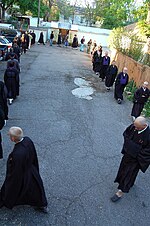Walking meditation

Walking meditation, sometimes known as kinhin (Chinese: 經行; Pinyin: jīngxíng; Romanji: kinhin or kyōgyō; Korean: gyeonghyaeng; Vietnamese: kinh hành), is a practice within several forms of Buddhism that involve movement and periods of walking between long periods of sitting meditation.[1] In different forms, the practice is common in various traditions of both Theravada and in Mahayana Buddhism.
Practice[]
Practitioners typically walk clockwise around a room while holding their hands in a gesture with one hand closed in a fist while the other hand grasps or covers the fist (Chinese: 叉手; pinyin: chā shǒu; romanji: shashu).[2] During walking meditation each step is taken after each full breath.[3] The pace of walking meditation can be either slow (several steady steps per each breath) or brisk, almost to the point of jogging.[2]
Etymology[]
The term kinhin consists of the Chinese words 經, meaning "to go through (like the thread in a loom)", with "sutra" as a secondary meaning, and 行, meaning "walk". Taken literally, the phrase means "to walk straight back and forth."
Health benefits[]
This section needs more medical references for verification or relies too heavily on primary sources. (June 2021) |
Studies on the elderly, type 2 diabetes patients, and nursing students all demonstrate wide health benefits. Although research is in some cases tentative, results suggest that there are numerous health benefits to walking meditation. One common connection is a reduction/regulation of cortisol in the blood,[4][5] which is the body's primary stress indicating hormone. While the body and mind are working harder, stress regulating factors decrease. One study of elderly women practicing walking meditation suggests mindful walking is somehow linked to decreases in depression and stress, in addition to increases in bone development.[5] Another study based on Tai chi meditation speculates a link between walking meditation and the production of catecholamines, which are linked to the brain's response to stress.[6] Recent advances in medical science also suggest that promoting peace and mindfulness are linked to neuronal regeneration.[7] The act of walking peacefully and with intention is curative to one who practices it.
Several studies have shown that anxiety can be reduced through physical activities and meditation.[8] This is beneficial for young adults who have anxiety disorder.[8] In 2017, university researchers conducted an experiment on these young adults.[8] The purpose of this experiment is to find what would help young adults cope with anxiety.[8] In this experiment, the young adults were split into 5 groups brisk walking, meditation, walking meditation, meditation then walking and sitting.[8] The researchers discovered one common factor in reducing anxiety, which is meditation. Three out of five groups that did meditation had the same amount of reduction in anxiety.[8] However, the two groups that did not make any changes were brisk walking and sitting.[8] In conclusion, regular meditation, walking meditation, meditation plus walking all have the same effects on anxiety.[8]
See also[]
References[]
- ^ Maezumi & Glassman 2002, pp. 48–9.
- ^ a b Aitken 1999, pp. 35–6.
- ^ "Kinhin". Empty Bowl Zendo. Retrieved April 1, 2015.
- ^ Jin, Putai (1992-05-01). "Efficacy of Tai Chi, brisk walking, meditation, and reading in reducing mental and emotional stress". Journal of Psychosomatic Research. 36 (4): 361–370. doi:10.1016/0022-3999(92)90072-A. ISSN 0022-3999. PMID 1593511.
- ^ a b Prakhinkit, Susaree; Suppapitiporn, Siriluck; Tanaka, Hirofumi; Suksom, Daroonwan (May 2014). "Effects of Buddhism Walking Meditation on Depression, Functional Fitness, and Endothelium-Dependent Vasodilation in Depressed Elderly". The Journal of Alternative and Complementary Medicine. 20 (5): 411–416. doi:10.1089/acm.2013.0205. ISSN 1075-5535. PMID 24372522.
- ^ Jin, Putai (May 1992). "Efficacy of Tai Chi, brisk walking, meditation, and reading in reducing mental and emotional stress". Journal of Psychosomatic Research. 36 (4): 361–370. doi:10.1016/0022-3999(92)90072-a. ISSN 0022-3999. PMID 1593511.
- ^ Chatutain, Apsornsawan; Pattana, Jindarut; Parinsarum, Tunyakarn; Lapanantasin, Saitida (July 2019). "Walking meditation promotes ankle proprioception and balance performance among elderly women". Journal of Bodywork and Movement Therapies. 23 (3): 652–657. doi:10.1016/j.jbmt.2018.09.152. PMID 31563384.
- ^ a b c d e f g h Edwards, Meghan K.; Rosenbaum, Simon; Loprinzi, Paul D. (2018). "Differential Experimental Effects of a Short Bout of Walking, Meditation, or Combination of Walking and Meditation on State Anxiety Among Young Adults". American Journal of Health Promotion. 32 (4): 949–958. doi:10.1177/0890117117744913.
Bibliography[]
- Aitken, Robert (1999). Taking the Path of Zen. North Point Press. pp. 35–36. ISBN 0-86547080-4.
- Maezumi, Hakuyu Taizan; Glassman, Bernie (2002). On Zen Practice: Body, Breath, Mind. Wisdom Publications. pp. 48–49. ISBN 086171315X.
- Jin, Putai. "Efficacy of Tai Chi, Brisk Walking, Meditation, and Reading In Reducing Mental and Emotional Stress". doi.org/10.1016/0022-3999(92)90072-A
- Prakhinkit, Susaree "Effects of Buddhist Walking Meditation on glycemic control and vascular functions in patients with Type-2 Diabetes." Journal of Alternative and Complementary Medicine doi.org/10.1016/j.ctim.2016.03.009
- Prakhinkit, Susaree Journal of Alternative and Complementary Medicine, vol. 20, no. 5, 2014, doi.org/10.1089/acm.2013.0205
- Chatutain, Apsornsawan “Walking Meditation Promotes Ankle Proprioception and Balance Performance among Elderly Women.” doi.org/10.1016/j.jbmt.2018.09.152
- Smith, Alison. “Walking Meditation: Being Present and Being Pilgrim on the Camino De Santiago.” Religions, vol. 9, no. 3, 2018, p. 82., doi:10.3390/rel9030082
- Zen
- Buddhist meditation
- Walking
- Zazen